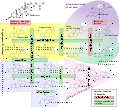
P450c17
Encyclopedia
CYP17A1 also known as cytochrome P450 17A1, or steroid 17-alpha-monooxygenase, or 17α-hydroxylase/17,20 lyase/17,20 desmolase is a cytochrome P450 enzyme that acts upon pregnenolone
and progesterone
to add a hydroxyl
(-OH) group at carbon 17 of the steroid D ring (the hydroxylase activity), or acts upon 17-hydroxyprogesterone and 17-hydroxypregnenolone to split the side-chain off the steroid nucleus (the lyase
activity).
 This gene encodes a member of the cytochrome P450 superfamily of enzyme
This gene encodes a member of the cytochrome P450 superfamily of enzyme
s. The cytochrome P450 proteins are monooxygenase
s that catalyze many reactions involved in drug metabolism and synthesis of cholesterol
, steroid
s, and other lipid
s. This protein localizes to the endoplasmic reticulum
. It has both 17alpha-hydroxylase and 17,20-lyase activities, and is a key enzyme in the steroidogenic pathway that produces progestin
s, mineralocorticoid
s, glucocorticoid
s, androgen
s, and estrogen
s. Mutations in this gene are associated with 17 alpha-hydroxylase deficiency
, 17 alpha-hydroxylase/17,20-lyase deficiency, pseudohermaphroditism
, and adrenal hyperplasia.

Pregnenolone
Pregnenolone is a steroid hormone involved in the steroidogenesis of progesterone, mineralocorticoids, glucocorticoids, androgens, and estrogens. As such it is a prohormone. Pregnenolone sulfate is a GABAA antagonist and increases neurogenesis in the hippocampus.-Chemistry:Like other steroids,...
and progesterone
Progesterone
Progesterone also known as P4 is a C-21 steroid hormone involved in the female menstrual cycle, pregnancy and embryogenesis of humans and other species...
to add a hydroxyl
Hydroxyl
A hydroxyl is a chemical group containing an oxygen atom covalently bonded with a hydrogen atom. In inorganic chemistry, the hydroxyl group is known as the hydroxide ion, and scientists and reference works generally use these different terms though they refer to the same chemical structure in...
(-OH) group at carbon 17 of the steroid D ring (the hydroxylase activity), or acts upon 17-hydroxyprogesterone and 17-hydroxypregnenolone to split the side-chain off the steroid nucleus (the lyase
Lyase
In biochemistry, a lyase is an enzyme that catalyzes the breaking of various chemical bonds by means other than hydrolysis and oxidation, often forming a new double bond or a new ring structure...
activity).

Enzyme
Enzymes are proteins that catalyze chemical reactions. In enzymatic reactions, the molecules at the beginning of the process, called substrates, are converted into different molecules, called products. Almost all chemical reactions in a biological cell need enzymes in order to occur at rates...
s. The cytochrome P450 proteins are monooxygenase
Monooxygenase
Monooxygenases are enzymes that incorporate one hydroxyl group into substrates in many metabolic pathways. In this reaction, two atoms of dioxygen are reduced to one hydroxyl group and one H2O molecule by the concomitant oxidation of NADH.-Classification:...
s that catalyze many reactions involved in drug metabolism and synthesis of cholesterol
Cholesterol
Cholesterol is a complex isoprenoid. Specifically, it is a waxy steroid of fat that is produced in the liver or intestines. It is used to produce hormones and cell membranes and is transported in the blood plasma of all mammals. It is an essential structural component of mammalian cell membranes...
, steroid
Steroid
A steroid is a type of organic compound that contains a characteristic arrangement of four cycloalkane rings that are joined to each other. Examples of steroids include the dietary fat cholesterol, the sex hormones estradiol and testosterone, and the anti-inflammatory drug dexamethasone.The core...
s, and other lipid
Lipid
Lipids constitute a broad group of naturally occurring molecules that include fats, waxes, sterols, fat-soluble vitamins , monoglycerides, diglycerides, triglycerides, phospholipids, and others...
s. This protein localizes to the endoplasmic reticulum
Endoplasmic reticulum
The endoplasmic reticulum is an organelle of cells in eukaryotic organisms that forms an interconnected network of tubules, vesicles, and cisternae...
. It has both 17alpha-hydroxylase and 17,20-lyase activities, and is a key enzyme in the steroidogenic pathway that produces progestin
Progestin
A progestin is a synthetic progestogen that has progestinic effects similar to progesterone. The two most common uses of progestins are for hormonal contraception , and to prevent endometrial hyperplasia from unopposed estrogen in hormone replacement therapy...
s, mineralocorticoid
Mineralocorticoid
Mineralocorticoids are a class of steroid hormones characterised by their similarity to aldosterone and their influence on salt and water balances.-Physiology:...
s, glucocorticoid
Glucocorticoid
Glucocorticoids are a class of steroid hormones that bind to the glucocorticoid receptor , which is present in almost every vertebrate animal cell...
s, androgen
Androgen
Androgen, also called androgenic hormone or testoid, is the generic term for any natural or synthetic compound, usually a steroid hormone, that stimulates or controls the development and maintenance of male characteristics in vertebrates by binding to androgen receptors...
s, and estrogen
Estrogen
Estrogens , oestrogens , or œstrogens, are a group of compounds named for their importance in the estrous cycle of humans and other animals. They are the primary female sex hormones. Natural estrogens are steroid hormones, while some synthetic ones are non-steroidal...
s. Mutations in this gene are associated with 17 alpha-hydroxylase deficiency
Congenital adrenal hyperplasia due to 17 alpha-hydroxylase deficiency
Congenital adrenal hyperplasia due to 17α-hydroxylase deficiency is an uncommon form of congenital adrenal hyperplasia resulting from a defect in the gene for the enzyme CYP17A1. It produces decreased synthesis of both cortisol and sex steroids, with resulting increase in mineralocorticoid production...
, 17 alpha-hydroxylase/17,20-lyase deficiency, pseudohermaphroditism
Pseudohermaphroditism
Pseudohermaphroditism, or pseudo-hermaphroditism, is the condition in which an organism is born with secondary sex characteristics or a phenotype that is different from what would be expected on the basis of the gonadal tissue ....
, and adrenal hyperplasia.
Steroidogenesis


